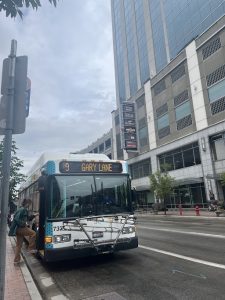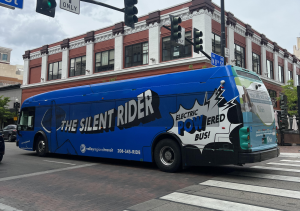Editor’s Note: This blog was authored by Jayden Rehwalt, ICL’s 2024 Andrus Scholar. As an environmental studies student at Boise State University, Jayden’s time with ICL is focused on climate and energy work.
While the Treasure Valley is not well known for having a user-friendly public transit system, changes are being implemented right now to improve that. Valley Regional Transit (VRT) just updated their route system and brought on 12 new fully electric buses to accommodate commuter demand!

“Change day” was June 3rd, with an increase in bus routes along routes that are already highly used to meet demand, an expansion in services to the Canyon County area, and improved cross-town connections. To learn more about the routes and real-time updates, VRT has designed an app “ETA Spot” that will help you get wherever you need to go. While some less-used bus routes have been discontinued, VRT is offering a partnership with Lyft to accommodate the loss of service and offering “Beyond ACCESS” for qualifying adults and persons with disabilities to offer no-cost trips for some routes.
This is all welcome news for those who rely on the system, as well as those who don’t—polling indicates that 86% of all U.S. voters are in favor of increasing public transportation in their county.
Routes aren’t the only thing changing. Payment amount and forms are also getting a revamp. There will be reduced fare for youth (6-18 years old), older adults (65+ years old), persons with disabilities, and Medicare cardholders. For Boise State Students, the city buses are free with a valid Student ID.
When it comes to how you pay, there’s an array of options. You can pay on the bus through fareboxes (using cash) or an Umo reader (for the Umo reader, you are able to use your Umo card or the Umo Mobility App on your smartphone). You can reload your card from digital payment and scan the QR code when you hop on the bus. For those who don’t use the app, you can scan your Umo card when boarding the bus, and recharge it whenever necessary. You can get those cards at Winco, Main Street Station, City Hall, and most Albertsons locations.
VRT has also been working on transforming their fleet of vehicles to be more climate friendly. The “Electric Fleet” offers quieter, low-emission rides at the same cost of a normal bus. With about 12 electric buses on the roads as of February 2024, VRT has plans to replace the rest of the 54 diesel buses for a fully electric public transportation system in the Treasure Valley.

The Climate Team at ICL—who are electric bus enthusiasts—decided to try out the new bus routes on the first day. In need of an afternoon pick-me-up, they embarked on a journey to a local milkshake drive-in. The day was stormy and rainy making for sketchy biking conditions. Additionally, high traffic areas such as State Street are not as bike friendly when heading out toward Garden City. So it made for a perfect trip on one of the new routes on State Street.

It was a smooth and fun trip thanks to the quick turnaround time of the new schedule. As the Treasure Valley continues rapid growth, it’s great to see how Valley Regional Transit is adapting to meet the needs of the community. These new routes will be especially helpful as new high-density housing is being built along transit corridors following Boise’s new planning and zoning code.
To see the new routes and times, VRT has created a virtual map to help to figure out which line will be the best option. All VRT buses have a bike rack and free wifi so next time your car isn’t working or you’re up for a new adventure, take a bus ride!
Stay updated on efforts to combat climate change by signing up for ICL Climate Program emails!

